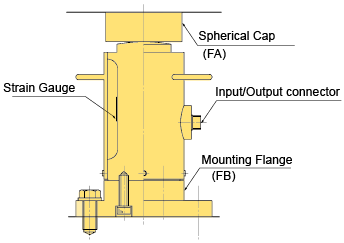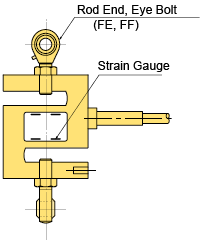The load cell is a transducer to detect load receiving the load directly by the load cell itself. Therefore, the load cell has to be treated as part of a structure. The load cell is calibrated to vertical load in the sensing direction. Eccentric load, transverse load, bending or shearing force may deteriorate accuracy and in the worst case cause damage.
In case of compression use
- A structure where a load cell is installed must sufficiently withstand loading. The base must be deformation or deflection free due to loading. In addition, the contact pressure of the bottom of load cell should be noted.
- The load cell should be installed so that the load can be applied vertically to the load cell. The top of load cell is so spherical that bending moment or distortion is not applied to the load cell. The use of a spherical cap is recommended.
- As the need arises, set up a safety device for break.
- Load cell accessories such as spherical cap and mounting flange are available

*In case the load cell is used for impact testing, larger capacity load cell has to be selected consdiering its shock acceleration component. In case of cyclic loading such as fatigue life test, the applied load shoudl be 1/2 of the load cell capacity.
*All load cells are self-temperature-compensated, but a sharp temperature variation makes the output instable. Take note not to receive direct sunlight.
In case of tension use
- In case the tension/compression load cell is used for tension, force is received by the screw thread. The strength of the thread is very important, and if fully loaded up to the rated capacity, stress at the thread becomes high. Therefore, a screw thread with 8 to 10 in strength gets necessary.
- For lifting load measurement, a measure for preventing the screw from rotating should be taken. In addition to high safety ratio, some safety stop in case of break should be also taken into account.
- Load Cell accessories such as rod end and eye bolt are available.

*The load cell has hermetically sealed structure but the use in adverse environments may badly influence its waterproofness and corrosion resistance.
*The shield of the load cell cable is not connected to the load cell body. For noise protection, connect the shield to the E (earth) terminal of a measuring instrument.
About the use of product test data and product seal
Our transducers are supplied with individual test data (certificate) and product seal on the body. The contents of the test data are exampled below and the seal includes the most necessary information.
Load Cells Output Polarity
Output from strain gauge-type load cells changes in the plus direction with regard to increased tensile force, and in the minus direction with regard to increased compressing force. This is in common with all load cells (tension load cells, compression load cells, and tension/compression load cells) except those for special applications (pedal force meter, etc.).
More Information


